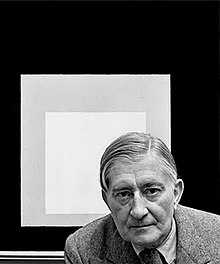 Josef Albers (/ˈælbərz, ˈɑːl-/; German: [ˈalbɐs]; March 19, 1888 – March 25, 1976) was a German-born American
artist and educator whose work, both in Europe and in the United
States, formed the basis of some of the most influential and
far-reaching art education programs of the twentieth century.
Josef Albers (/ˈælbərz, ˈɑːl-/; German: [ˈalbɐs]; March 19, 1888 – March 25, 1976) was a German-born American
artist and educator whose work, both in Europe and in the United
States, formed the basis of some of the most influential and
far-reaching art education programs of the twentieth century.He was known to meticulously list the specific manufacturer's colours and varnishes he used on the back of his works, as if the colours were catalogued components of an optical experiment. His work represents a transition between traditional European art and the new American art. It incorporated European influences from the Constructivists and the Bauhaus movement, and its intensity and smallness of scale were typically European, but his influence fell heavily on American artists of the late 1950s and the 1960s. "Hard-edge" abstract painters drew on his use of patterns and intense colors, while Op artists and conceptual artists further explored his interest in perception.
In an article about the artist, published in 1950, Elaine de Kooning concluded that however impersonal his paintings might at first appear, not one of them “could have been painted by any one but Josef Albers himself.” Although their relationship was often tense, and sometimes, even combative, Robert Rauschenberg later identified Albers as his most important teacher.
The Josef Albers papers, documents from 1929 to 1970, were donated by the artist to the Smithsonian Institution's Archives of American Art in 1969 and 1970. In 1971 (nearly five years before his death), Albers founded the Josef and Anni Albers Foundation, a nonprofit organization he hoped would further "the revelation and evocation of vision through art." Today, this organization not only serves as the office for the estates of both Josef Albers and his wife Anni Albers, but also supports exhibitions and publications focused on the works of both Albers. The official foundation building is located in Bethany, Connecticut, and "includes a central research and archival storage center to accommodate the Foundation's art collections, library and archives, and offices, as well as residence studios for visiting artists."
The U.S. copyright representative for the Josef and Anni Albers Foundation is the Artists Rights Society. The executive director of the foundation is Nicholas Fox Weber, an author of fourteen books. Later the foundation was instrumental in having four fakes from Italy, represented as the work of Albers and on sale in auction houses and galleries in France and Germany, seized by the police.
In 1997, one year after the auction house, Sotheby's, had bought the Andre Emmerich Gallery, the Josef and Anni Albers Foundation, the main beneficiary of the estates of both artists, did not renew its three-year contract with the gallery. Currently, the foundation is represented by The Pace Gallery in New York, Waddington Custot Galleries in London, and the Alan Cristea Gallery in London, and now, a large part of his estate is held by the Josef Albers Museum in Bottrop, Germany, where he was born.
Josef Albers select paintings:

